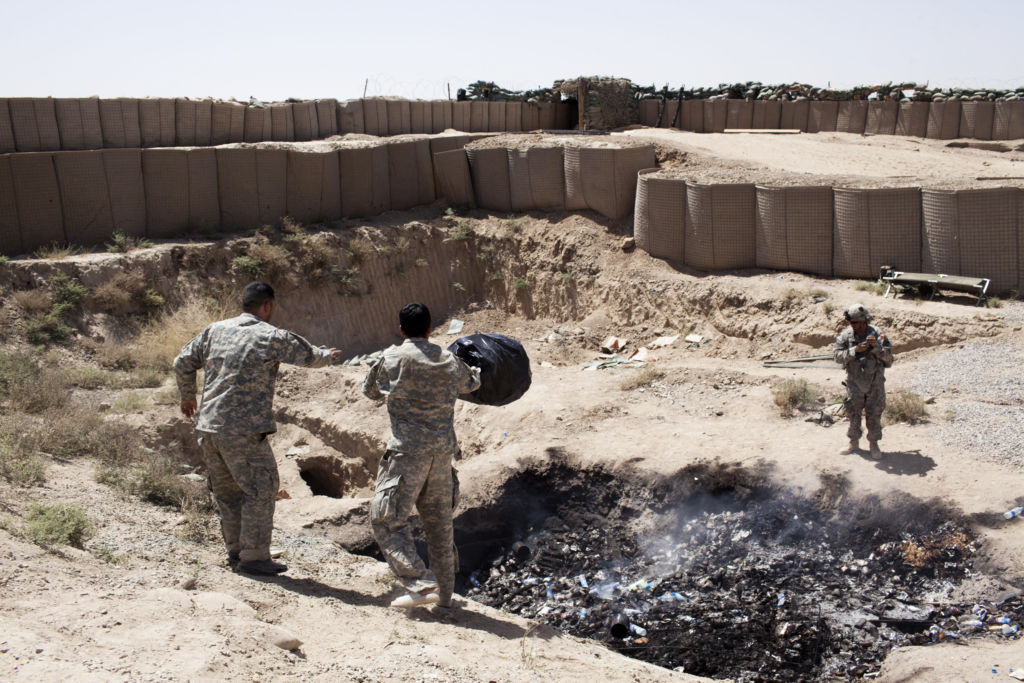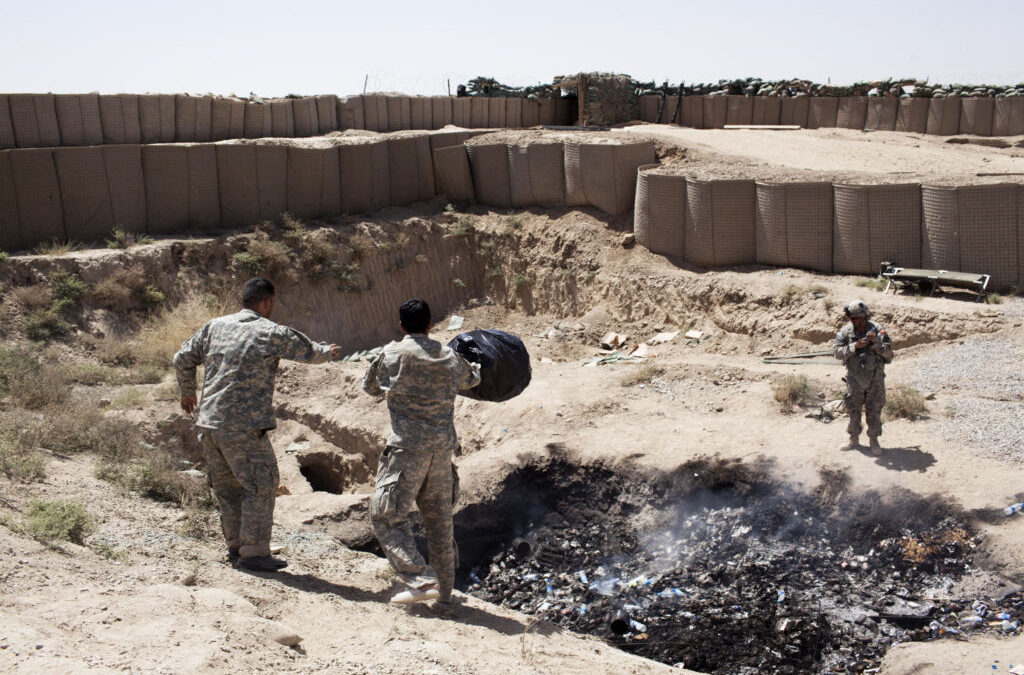
(Photo by Sebastian Meyer/Corbis via Getty Images)
by Inside EPA Publishers
President Joe Biden’s State of the Union (SOTU) call to better address health concerns about military veterans exposed to toxics from overseas “burn pits” is driving new efforts for policymakers to address the issue at home, with environmental advocates urging Congress to fund alternative military destruction technologies for munitions disposal and for EPA to impose long-sought limits on open burning.
Biden in his March 1 address raised concerns about potential adverse health effects veterans, including his late son Beau Biden, may face from exposures to the burn pits and urged lawmakers to approve H.R. 3967, pending legislation that would expand veterans’ access to healthcare and benefits from such exposures.
“We don’t know for sure if a burn pit was the cause of [Beau’s] brain cancer, or the diseases of so many of our troops. But I’m committed to finding out everything we can,” Biden said.
Burn pits — expansive, open-air pits for incinerating hazardous and other materials on-site — were used in the Iraq and Afghanistan wars by the U.S. military. Veterans have since complained of links between cancers and other diseases they believe are tied to particulate matter exposure from the burn pits, and the Department of Veterans Affairs (VA) last year added three presumptive respiratory conditions related to such exposures.
Biden also announced that the department is making treatment for nine forms of cancer eligible for VA benefits.
In the wake of his speech, an advocacy group is renewing calls for EPA to ban the practice.
The Institute for Public Accuracy (IPA), a non-profit group that highlights grassroots and progressive groups’ causes, in a March 2 press release noted the SOTU remarks and questioned why burn pits are also allowed in the United States, citing remarks made last September by Laura Olah, the national coordinator for the Cease Fire Campaign, to halt open burn/open detonation (OB/OD) permitting of energetic hazardous waste, which includes munitions and flares that contain hazardous waste and toxic chemicals.
“Nationwide, there are approximately 60 active private and public sector facilities that routinely conduct OB/OD of hazardous waste,” IPA says, citing Laura Olah, the Cease Fire Campaign’s national coordinator. Her remarks were part of a news release last September announcing more than 100 environmental and grassroots groups were urging EPA Administrator Michael Regan to immediately halt the military’s use of OB/OD to dispose of munitions wastes, saying it produces uncontrolled releases of per- and polyfluoroalkyl substances (PFAS) and other toxic chemicals.
All of the open burn facilities in the United States “are currently permitted by the EPA or allowed by the agency to operate under ‘interim status’ without any permit at all,” she noted. She added that munitions are the only industry still being permitted to burn hazardous waste into the air.
The push last fall renewed a long-time fight by grassroots environmental groups to stop the use of OB/OD for waste explosives — a practice for which the military is generally exempt from many environmental regulations for military munitions disposal although it is subject to certain EPA permitting standards.
In response, EPA Acting Assistant Administrator for the Office of Land & Emergency Management Barry Breen told Olah in a Nov. 24 letter that the environmentalist law firm Earthjustice had raised similar concerns and said EPA would meet with her to discuss the issue in December.
An EPA spokesperson did not respond to questions on whether the agency plans to make changes to its OB/OD permitting policies.
Advanced Treatment Technologies
But in a written response to Inside EPA, Olah stressed the need for Congress to appropriate money now for purchasing advanced treatment technologies “that can end the OB/OD of hazardous munitions waste,” noting that such alternative technologies have been successfully used in some communities. She says though “less powerful communities have to endure OB/OD — in fact nearly 95% of the operating OB/OD facilities are located in [environmental justice] communities.”
She noted that a 2018 National Academy of Sciences study on alternatives also cautioned “that such a shift by the military will be ‘impossible’ unless the Army has a clear directive for making the change and Congress provides sufficient, stable funding.”
EPA in recent years has signaled support for a shift away from open-air burning of waste explosives in favor of less-polluting alternative treatments, issuing a report in December 2019 in which the agency said there is a “wide range” of available alternatives that satisfy the safety mandates that were the main driver for using OB/OD. EPA on its website says OB/OD has been used to treat energetic hazardous waste.
“Nevertheless, OB/OD is still being used despite the availability of suitable and safe alternatives, in both the public and private sectors,” EPA’s report said. “Therefore, the information in this report should be useful to the regulated community in exploring alternatives to OB/OD.”
However, environmentalists continue to pressure the military to halt its use of such practices. Earthjustice Jan. 25 filed suit in the U.S. District Court for the District of Guam charging that the Air Force failed to take a “hard look” as required by the National Environmental Policy Act (NEPA) when it sought to extend its hazardous waste permit that would allow for the use of OB/OD for disposing of hazardous waste munitions at Andersen Air Force Base in Guam.
“The Air Force proposes to treat hazardous waste munitions at the EOD Range by blowing up waste munitions directly on the sand and burning waste munitions in the open air. By definition, open burning and open detonation both release the toxic by-products of burning and detonation — and sometimes unexploded ordnance — directly into the surrounding environment,” says the Jan 25 complaint in Prutehi Litekyan: Save Ritidian v. U.S. Air Force.
Meanwhile the White House Office of Management and Budget issued a March 1 statement of administration policy (SAP) strongly backing H.R. 3967.
“The Administration looks forward to working with the Congress to enact this legislation and ensuring it is effectively implemented,” the SAP says. “We must address the toxic legacy of environmental exposures sustained by veterans during their military service and fulfill our sacred obligation to our veterans, their families, caregivers, and survivors.”
It says that “H.R. 3967 would make changes to the definitions for who is eligible for VA health care based on presumed toxic exposure during military service, including from burn pits, radiation, or other environmental conditions.” It would also change the VA’s process for deciding presumptive service connections and mandate research studies on military-related environmental exposures, the SAP notes.
The bill has 100 co-sponsors, including three Republicans, and was reported out by the Committee on Veterans’ Affairs and discharged by the Armed Services Committee on Feb. 22. — Suzanne Yohannan (syohannan@iwpnews.com)
Published March 2, 2022

